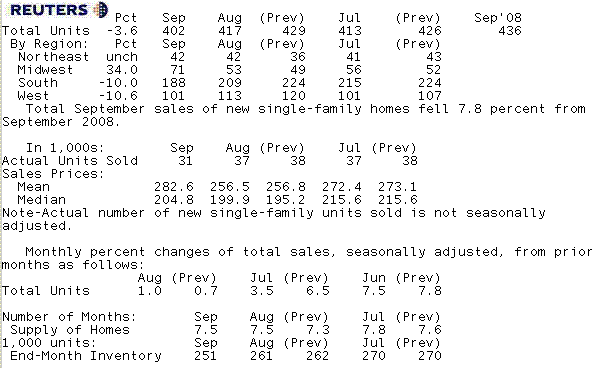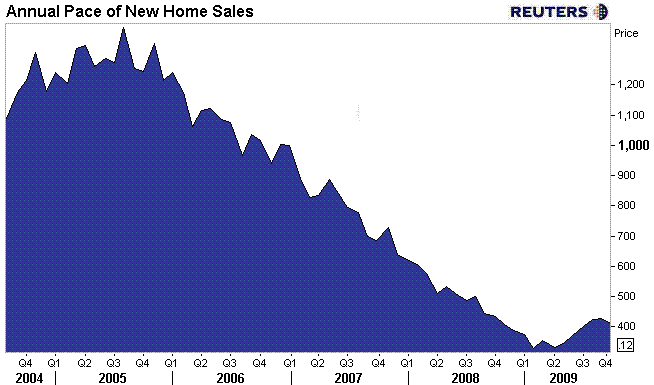The Census Bureau and the Department of Housing and Urban Development today released New Home Sales survey data for September 2009.
The survey is primarily based on a sample of houses selected from building permits. Since a “sale” is defined as a deposit taken or sales agreement signed, this can occur prior to a permit being issued. Changes in sales price data reflect changes in the distribution of houses by region, size, etc., as well as changes in the prices of houses with identical characteristics.
The size of the housing market combined with the broad influences it has over the economy make the real estate sector a reliable leading indicator of economic activity. Real estate is one of the first sectors to contract when a recession is looming and one of the first to show signs of recovery when economic activity begins to improve.
Think about the materials that go into building and maintaining a home....WOOD, STEEL, PLASTICS, WIRING, PIPING, CONCRETE, GLASS, ELECTRICITY, FURNITURE, CARPETING ,ELECTRONICS, APPLIANCES....LABOR.
How about the commissions earned by Realtors and mortgage originators who help the borrowers close on their home? What about the home sellers? They are either moving into a bigger house, which implies they will be spending to furnish their bigger home, or downsizing, which would imply a lower payment and therefore more disposable income to spend.
Plain and Simple: When homes are selling, money moves around the economy more efficiently.
Last month new home sales increased for the fifth straight month, but the 0.7% gain didn’t match the consensus estimate of +1.6%. The August 2009 annual pace of sales was 429,000, 3.4% below the August 2008 rate.
Not only were sales lower than expected, they were also so lopsided that only one of the four areas even experienced growth. Sales in the West jumped 12.1%, but sales fell 16.3% in Northeast and 5.8% in the Midwest, activity in the South was flat. There was some good news though: five months of sales increases caused excess inventory to dwindle. At that sales place there was just 7.3 months’ worth of supply on the market, compared with 7.6 months’ in July and 12.4 months’ at the beginning of the year.
This month single family new home sales fell for the first time since March. The annual pace of new homes sales was 402,000 sales per year, well below economist expectations for a pace of 440,000 annual new home sales. This is a 3.6% month over month decline. August new home sales data was also revised lower, from 429,000 to 417,000 sales per year.
New home supply was unchanged at 7.5 months. The median home sale price was 204,800, 9.1% lower from September 2008.
New home sales in the Northeast were unchanged, the Mid-West was 34% higher, the South experienced 10% less new home sales, and the West was 10.6% slower. Once again, only one geographical region experiences growth.
Here is a table summarizing the survey findings:

From the Census Bureau/HUD Press Release...
Sales of new one-family houses in September 2009 were at a seasonally adjusted annual rate of 402,000, according to estimates released jointly today by the U.S. Census Bureau and the Department of Housing and Urban Development.
This is 3.6 percent (±10.2%)* below the revised August rate of 417,000 and is 7.8 percent (±12.0%)* below the September 2008 estimate of 436,000. The median sales price of new houses sold in September 2009 was $204,800; the average sales price was $282,600.

Reminder: It takes 4 months to establish a trend for new houses sold.
Read yesterday's commentary on the S&P/Case Shiller Home Price Index for more MND perspective on the housing market.







